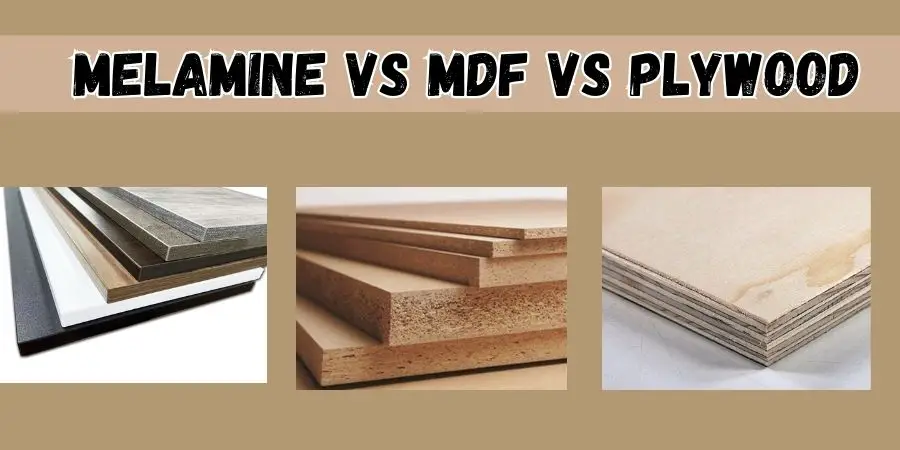When it comes to DIY and woodworking projects, choosing the right materials is really important. There are lots of different materials to choose from, but three of the most common are melamine, MDF, and plywood. Each material has its own unique properties and is best suited for different kinds of projects.
Melamine vs Mdf vs Plywood

Melamine:
Melamine is basically a fancy way of saying particleboard that’s covered in a really cool, scratch-resistant surface. It’s made by smashing up wood particles and gluing them together with a special resin. This mixture is then pressed together under high pressure to create a really strong and durable surface. Melamine is great for making things look really nice and fancy, like cabinets or wall panels, because you can get it in lots of colors and patterns.
Pros:
- Affordable
- Durable and scratch-resistant
- Easy to clean and maintain
- Available in a variety of colors and patterns
Cons:
- Not as strong as MDF or plywood
- Cannot be sanded or refinished
- Not suitable for high-moisture areas like bathrooms or kitchens
MDF:
MDF stands for medium-density fiberboard. It’s a bit like melamine in that it’s made by breaking down wood fibers, but it’s a bit more high-tech. They mix the wood fibers with a special glue that makes it really dense and uniform. MDF is a bit stronger than melamine and has a smooth surface that’s perfect for painting. People use it for all kinds of stuff, from furniture to decorative wall panels.
Pros:
- Smooth and uniform surface that’s easy to paint
- Strong and durable
- Resistant to warping and cracking
- More affordable than plywood
Cons:
- Prone to swelling and warping if exposed to moisture
- Heavier than melamine
- May contain formaldehyde, a chemical that can be harmful if not properly sealed
Plywood:
Plywood is a bit different from melamine and MDF because it’s made by gluing together thin layers of wood veneer in different directions. It’s really strong and versatile and is often used for outdoor projects and construction. It doesn’t warp or crack easily, which makes it perfect for things like building a deck or a shed. Plywood comes in different grades and thicknesses, so you can find the right kind for your project.
Pros:
- Strong and versatile
- Resistant to warping and cracking
- Available in a range of grades and thicknesses
- Can be used for outdoor projects
Cons:
- More expensive than melamine and MDF
- Not as smooth or paintable as MDF
- Prone to splitting or cracking at the edges
Best for
Melamine:
Melamine is best for making things look really fancy and cool. It’s great for cabinets, shelving, and decorative wall panels. You can get it in lots of colors and patterns, so you can make your project look exactly the way you want it to.
Melamine uses:
- Cabinets
- Shelves
- Furniture
- Display cases
- Wall paneling
MDF:
MDF is perfect for projects that need a smooth surface, like furniture and decorative wall panels. It’s really easy to paint, so you can make it any color you want. It’s also a bit stronger than melamine, so it can handle a bit more weight.
MDF uses
- Cabinetry
- Furniture
- Molding and trim
- Speaker boxes
- Decorative wall panels
Plywood:
Plywood is really versatile and is great for all kinds of projects. It’s really strong, so it’s perfect for things like building a deck or a shed. You can also use it for indoor projects like furniture and cabinets. It comes in different grades and thicknesses, so you can find the right kind for your project.
Plywood uses
- Construction (roofing, flooring, walls, etc.)
- Furniture
- Decks and outdoor structures
- Shipping containers
- Musical instruments
Which one should you choose?
When deciding between melamine, MDF, and plywood for your project, there are several factors to consider. Here are some key things to keep in mind:
Budget:
Melamine is typically the most affordable option, followed by MDF and then plywood. If cost is a major factor for you, melamine may be the best choice.
Durability:
If you need a material that can withstand wear and tear, melamine is a good option thanks to its scratch-resistant coating. However, if you need something stronger, MDF or plywood may be a better choice.
Moisture Resistance:
If your project will be exposed to moisture or humidity, you’ll want to choose a material that can hold up well in these conditions. Melamine is moisture-resistant, but MDF and plywood can be prone to swelling and warping if exposed to too much moisture.
Paintability:
If you plan to paint your project, MDF is a good choice thanks to its smooth surface that takes paint well. Melamine can also be painted, but it may require a bit more prep work to ensure the paint adheres properly. Plywood is not as smooth or paintable as MDF.
Strength:
If you need a material that can support weight or withstand heavy use, plywood is a good option thanks to its layered construction. MDF is also strong, but not as much as plywood. Melamine is the least strong of the three materials.
Appearance:
Finally, consider the look you’re going for. Melamine is available in a wide range of colors and patterns, while MDF and plywood have a more natural look. MDF can be painted any color, while plywood has a distinctive wood grain pattern.





